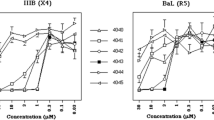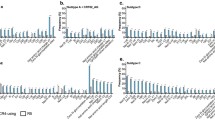Abstract
A quantitative coculture assay is described for determining susceptibility of HIV-1 isolates to zidovudine and sCD4 (178)-PE40 (a 60 kDa hybrid protein consisting of the gp120 binding region of CD4 linked to the translocation and ADP-ribosylation regions ofPseudomonas aeruginosa exotoxin). The assay was relatively simple to perform and gave highly reproducible results often within three to five days. IC50 values of zidovudine for HIV-1 strains isolated from two AIDS patients and an asymptomatic seropositive individual were in the range 0.001–0.002 µmol. Isolates obtained after six months of zidovudine treatment had zidovudine IC50 values of 0.01–0.5 µmol. All isolates were equally sensitive to sCD4 (178)-PE40 (IC50 1–5 µg/ml). HIV-1 activation in the chronically infected cell line U-1 was inhibited by sCD4 (178)-PE40 but not by zidovudine.
Similar content being viewed by others
References
Fischl MA, Richman DD, Grieco MH, Gottlieb MS, Volberding PA, Laskin OL, Leedom JM, Groopman JE, Mildvan D, Schooley RT, Jackson GG, Duracr DT, Putt D, King D, andthe AZT Collaboration Working Group The efficacy of azidothymidine in the treatment of patients with AIDS and AIDS-related complex. A double-blind, placebo controlled trial. New England Journal of Medicine 1987, 317: 185–191.
Fischl MA, Richman DD, Hansen N, Collier AC, Carey JT, Para MF, Hardy WD, Dolin R, Powderly WG, Allan JD, Wong B, Merrigan TC, McAuliffe A, Hyslop NE, Rhame FS, Balfour HH, Spector SA, Volberding PA, Pettinelli G, Anderson J, andthe AIDS Clinical Trials Group The safety and efficacy of zidovudine in the treatment of subjects with mildly symptomatic human immunodeficiency versus type 1 infection. Annals of Internal Medicine 1990, 112: 727–737.
Folks TM, Kessler SW, Orenstein JM, Justement JS, Jaffe ES, Fauci AS Infection and replication of HIV-1 in purified progenitor cells of normal human bone marrow. Science 1988, 242: 919–922.
Yarchoan R, Mitsuya H, Myers CE, Broder S Clinical pharmacology of 3′-azido-2, 3′-dideoxythymidine (zidovudine) and related dideoxynucleosides. New England Journal of Medicine 1989, 321: 726–738.
Gelmon K, Montaner JSG, Fanning M Nature, time course and dose dependence of zidovudine-related side effects: results from the multicenter Canadian azidothymidine trial. AIDS 1989, 3: 555–561.
Gill PS, Rarick M, Brynes RK, Causey D, Loureiro C, Levine AM Azidothymidine associated with bone marrow failure in the acquired immunodeficiency syndrome. Annals of Internal Medicine 1978, 107: 502–505.
Larder BA, Darby G, Richman DD HIV with reduced sensitivity to zidovudine isolated during prolonged therapy. Science 1989, 243: 1731–1734.
Richman DD Susceptibility to nucleoside analogous of zidovudine-resistant isolates of human immuno-deficiency virus. American Journal of Medicine 1990, 88, Supplement 5B: 8–10.
Chaudhary VK, Mizukami T, Fuerst TR, Fitzgerald DJ, Moss B, Pastan I, Berger EA Selective killing of HIV-1 infected cells by recombinant human CD4-Pseudomonas exotin hybrid protein. Nature 1988, 335: 369–372.
Berger EA, Clouse KA, Chaudhary VK, Chakrabarti S, Fitzgerald DJ, Pastan I, Moss B CD4-Pseudomonas exotin hybrid protein blocks the spread of human immunodeficiency virus infection in vitro and is active against cells expressing the envelope glycoprotein from diverse immunodeficiency retroviruses. Proceedings of the National Academy of Sciences of the United States of America 1989, 86: 9539–9543.
Larder BA, Chesebro B, Richman DD Susceptibilities of zidovudine-susceptible and -resistant human immunodeficiency virus isolates to antiviral agents determined by using a quantitative plaque reduction assay. Antimicrobial Agents and Chemotherapy 1990, 34: 436–441.
Baba M, Pauwels R, Balzarini J, Herdewijn P, De Clercq E Selective inhibition of human immuno-deficiency virus (HIV) by 3′-azido-2′3′-dideoxyguanosine in vitro. Biochemical and Biophysical Research Communications 1987, 45: 1080–1086.
Hamamoto Y, Nakashima H, Matsui T, Matsuda A, Ueda T, Yamamoto N Inhibitory effect of 2′,3′-didehydro-2′,3′-dideoxynucleosides on infectivity, cytopathic effects, and replication of human immunodeficiency virus. Antimicrobial Agents and Chemotherapy, 1987, 31: 907–910.
Peterson PK, Sharp BM, Gekker G, Portoghese PS, Sammerud K, Balfour HH Morphine promoted the growth of HIV-1 in human peripheral blood mononuclear cell coculture. AIDS 1990, 4: 869–873.
Jackson JB, Kwok SY, Sninsky JJ, Hopsicker JS, Sannerud KJ, Rhame FS, Henry K, Simpson M, Balfour HH Human immunodeficiency virus type 1 detected in all seropositive symptomatic and asymptomatic individuals. Journal of Clinical Microbiology 1990, 28: 16–19.
Jackson JB, Coombs RW, Sannerud K, Rhame FS, Balfour HH Rapid and sensitive viral culture method for human immunodeficiency virus type 1. Journal of Clinical Microbiology 1988, 26: 1416–1418.
Larder BA, Darby G, Richman DD HIV-1 with reduces sensitivity to zidovudine isolated during prolonged therapy. Science 1989, 243: 1731–1734.
Szenbeni J, Patel SS, Hung K, Wahl LM, Weinstein JN Effects of thymidine and uridine on the phosphorylation of 3′-azido- 3′-deoxythymidine (zidovudine) in human mononuclear cells. Antimicrobial Agents and Chemotherapy 1991, 35: 198–200.
Larder BA, Kemp SD Multiple mutations in HIV-1 reverse transcriptase confer high-level resistance to zidovudine. Science 1989, 246: 1155–1158.
Poli G, Orenstein JM, Kinter A, Folks TM, Fauci AS Interferon α but not ZDV suppresses HIV-1 expression in chronically infected cell lines. Science 1989, 244: 575–577.
Pincus SH, Wehrly K ZDV demonstrates anti-HIV-1 activity in persistently infected cell lines: Implications for combination chemotherapy and immunotherapy. Journal of Infectious Diseases 1990, 162: 1233–1238.
Rooke R, Tremblay M, Wainberg MA ZDV (zidovudine) may act post-integrationally to inhibit generation of HIV-1 progeny virus in chronically infected cells. Virology 1990, 176: 205–215.
Author information
Authors and Affiliations
Rights and permissions
About this article
Cite this article
Verhoef, J., Gekker, G., Erice, A. et al. Quantitative assay for testing susceptibility of HIV isolates to zidovudine and sCD4 (178)-PE40. Eur. J. Clin. Microbiol. Infect. Dis. 11, 715–721 (1992). https://doi.org/10.1007/BF01989976
Issue Date:
DOI: https://doi.org/10.1007/BF01989976




